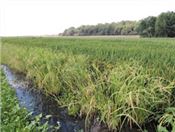Reviton, Rogue Receive EPA Labels For Arkansas, Offer Growers New Tools In Time For Spring Burndown
RYAN MCGEENEY
LITTLE ROCK, ARKANSAS
The U.S. Environmental Protection Agency has issued new labels for two herbicides, offering growers new tools for the 2022 growing season.
Reviton, a marketed tiafenacil formulation, is a broadleaf herbicide newly labeled for aerial applications in Arkansas. Tommy Butts, extension weed scientist for the University of Arkansas System Division of Agriculture, said the addition of the 24C classification, will likely prove to be a key benefit for growers as spring burndown applications continue.
“It’s another tool in the toolbox,” Butts said. “In a year of limited supply and high prices, that’s especially important.”
Reviton is part of a chemical family known as PPO inhibitors, which, among other things, prevent production of chlorophyll and destroy cell membranes. Under the Section 24C special local needs label, Arkansas farmers will be able to use Reviton for pre-plant and pre-emergence burndown in corn except sweet corn and popcorn. It can also be used pre-plant in soybeans and cotton.
One of the most important facets of Reviton is that it may be safely tank-mixed with clethodim, which controls ryegrass and other grassy weeds.
“We haven’t seen negative interactions when it’s mixed with clethodim, which tends to have limited tank-mix partners, because a lot of other herbicides will affect clethodim’s effectiveness,” Butts said. “Reviton primarily goes after broadleaf weeds – but can provide a boost to grass control – and clethodim goes after grasses, so the fact that those two can be mixed together is a nice option as a tank-mix.”
Rogue – the active ingredient of which is benzobicyclon — is a post- flood rice herbicide that provides a new method of control for weed species such as flatsedge and sprangletop, and helps suppress weedy rice.
Farmers have to be certified to use Rogue. Among other things, Rogue needs to be sprayed into flood water and should be used only zero- grade and straight levee fields where water can be held with little or no movement, Butts said.
“The herbicide itself isn’t a new mode of action, but it’s a new mode of action in rice,” Butts said. “We’ve never had an HPPD inhibitor before that we could use in rice.”
HPPD inhibitors work by effectively bleaching weeds, shutting down photosynthesis and causing them to wilt and die.
Butts said Rogue is especially beneficial because of increasing resistance issues associated with other herbicides already in use throughout the mid-South.
“When you have herbicide resistance, normally it’s to a specific mode of action,” he said. “With this one being a completely different mode of action never used before in rice, it opens the door a little more.”
Use of product names in this story does not imply endorsement by the University of Arkansas System Division of Agriculture. ∆
RYAN MCGEENEY: University of Arkansas

Weedy rice is a common problem in Arkansas rice agriculture. New labels from the EPA will give growers additional
tools to control the weed and similar grasses this year.
Division of Agriculture photo